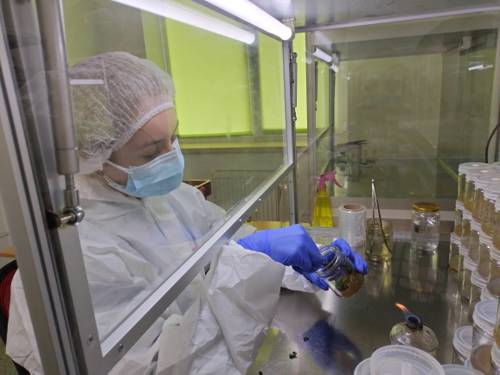
FAQ About Micropropagation for Indoor Herb Gardens

What is micropropagation?
Micropropagation is a modern plant propagation technique used to produce a large number of plants from a small tissue sample in a controlled, sterile environment. This technique utilizes tissue culture methods and is commonly used for cloning plants to ensure they are genetically identical to the parent plant.

Why is micropropagation beneficial for indoor herb gardens?
Micropropagation is beneficial for indoor herb gardens because it allows for the consistent and rapid production of healthy, disease-free plants throughout the year. It also helps in conserving plant genetics and produces plants that are uniform in growth and flavor, essential for maintaining the quality of herb gardens.

How does micropropagation differ from traditional propagation methods?
Traditional propagation methods typically involve growing plants from seeds or cuttings, which can be time-consuming and may not yield genetically identical plants. Micropropagation, on the other hand, reproduces plants in vitro from a small sample of tissue, ensuring the production of identical clones that can be produced in large quantities quickly.

Can micropropagation be used for all types of herbs?
Most herbs can be propagated using micropropagation techniques, though some species respond better than others due to differences in their physiological and molecular characteristics. The ease of micropropagation may vary depending on the specific biology of the herb in question.

What are the stages of micropropagation?
Micropropagation generally involves several stages: initialization, where the tissue is prepared and cultured; multiplication, where the growth medium encourages the formation of multiple shoots; rooting, where shoots are transferred to a medium to induce root formation; and acclimatization, where the plants are gradually adapted to external conditions. Each stage requires specific conditions to ensure successful growth.

Is it possible to perform micropropagation at home?
While micropropagation is typically done in a laboratory setting due to the need for sterile conditions and controlled environments, it can be attempted at home. However, it requires specialized equipment, such as laminar flow hoods, growth media, and controlled growing environments, which can be expensive and complex for hobbyists.

What equipment is needed for micropropagation?
Micropropagation requires a range of equipment, including a sterile laminar flow hood, culture vessels, precise measuring tools, growth media, growth chambers or incubators for temperature control, and tools for sterilizing and transferring plant materials. This equipment helps maintain sterile conditions essential for successful micropropagation.

Are there any drawbacks to using micropropagation for herb production?
While micropropagation is highly efficient and effective, it can have drawbacks, such as the high cost of initial setup and the need for technical expertise. Additionally, maintaining sterile conditions is critical to prevent contamination, which can lead to losses.

How long does micropropagation take from start to finish?
The time taken for micropropagation depends on the plant species and growth conditions but generally ranges from a few weeks to several months. The process involves various phases, such as tissue culturing, shoot and root formation, and acclimatization, each contributing to the overall timeline.

What are the common media used in micropropagation?
The most commonly used media for micropropagation are Murashige and Skoog (MS) medium, Gamborg’s B5 medium, and Linsmaier and Skoog (LS) medium. These media provide essential nutrients and hormones that aid in the growth and development of the plant tissues during different stages of propagation.

How important is sterility in micropropagation?
Sterility is critically important in micropropagation as it prevents contamination of the growth medium by bacteria, fungi, and other microorganisms that can disrupt or halt plant growth. Maintaining sterile conditions throughout the process is essential for the success of micropropagation.

Can micropropagation lead to genetic variations?
Typically, micropropagation aims to produce genetically identical plants, known as clones, from the parent plant. However, sometimes somaclonal variations can occur due to spontaneous mutations during tissue culture, potentially leading to genetic differences among the propagated plants.

Is micropropagation environmentally sustainable?
Micropropagation is considered environmentally sustainable as it maximizes plant production efficiency and conserves genetic resources. By enabling the year-round cultivation of herbs without the need for soil or extensive land use, it also reduces the carbon footprint associated with traditional agricultural practices.

What are common challenges faced in micropropagation?
Challenges faced in micropropagation include maintaining aseptic conditions, managing somaclonal variations, optimizing growth media for different plant species, and ensuring successful acclimatization of plants to external environments. Overcoming these challenges requires technical expertise and careful monitoring of the process.

How can I ensure successful micropropagation at home?
To ensure successful micropropagation at home, invest in quality equipment, maintain strict sterile protocols, and gain a good understanding of the plant species you are working with. Start with small, low-risk projects to build experience before attempting more complex micropropagations.

Does micropropagation require artificial lighting conditions?
Yes, micropropagation often requires artificial lighting to provide the necessary light intensity and duration for optimal plant growth. Common lighting setups include fluorescent lights or LED grow lights, which can be adjusted to replicate natural sunlight conditions required by the plant species being propagated.

Can beginners easily learn micropropagation techniques?
Beginners can learn micropropagation techniques, but it requires a significant investment of time to understand the procedures and equipment involved. Training courses, workshops, and hands-on practice can be helpful resources for learning and developing the necessary skills.

Is it cost-effective to use micropropagation for small-scale herb gardens?
For small-scale operations, micropropagation may not be cost-effective due to the initial investment required in equipment and materials. However, it becomes more viable as the scale increases, allowing growers to take advantage of the technique's efficiency in producing large quantities of plants.

How do plant hormones affect micropropagation?
Plant hormones such as auxins, cytokinins, and gibberellins play crucial roles in micropropagation by influencing various growth processes. They can be used to regulate root and shoot development, cell division, and elongation, ensuring effective multiplication and growth of plant tissues in culture.

What are the main applications of micropropagation?
Micropropagation is widely used in horticulture, agriculture, and conservation to rapidly produce large quantities of plants, ensure the preservation of plant genetics, and aid in the rehabilitation of endangered species. In the context of indoor herb gardens, it allows for the continuous supply of herbs all year long.
